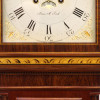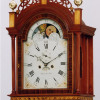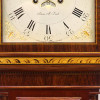- Clocks
- Tall Case Clock
Tall Case Clock
SL
Steven Lash
Updated
1188 0 4 0
Member Gallery
Maker Name
Lash, Steve
Accession Number
2018.078
Period
Federal
Year Made
1997
Place Made
Bloomfield Hills, MI
Address
Street
4331 Geisler Ct.
City
Bloomfield Hills
State
MI
Zip
48301
Country
USA
Contact
Email
This clock is designed after a pair of rare tall case clocks that quite possibly may be the only known clocks attributed to clockmaker Simon Willard and the Seymour cabinetmaking shop of Boston. Although the original clocks were 109" tall, my clock is 102" in height; scaled to fit a room that has an eight-foot ceiling when its center hood finial is removed. The late Gerhard Hartwigs of Paupack, PA. made the movement along with the twelve-inch dial plate.
BACK AND BASE: The back and base of the clock are made of eastern white pine. The sides of the base are veneered with straight grained Honduras mahogany and the front is veneered with a center panel of crotch mahogany within a crossband of rosewood and a border of mahogany. Strings of satinwood separate all the veneers. The French style curved feet are solid mahogany veneered with mahogany. A crossband of rosewood bordered with satinwood stings is inlaid at the top and sides of the feet.
WAIST: The sides of the waist are constructed of solid mahogany and are not veneered. The front of the waist is made of pine veneered with mahogany. The waist door is made of non-wormy chestnut and repeats the veneer pattern of the base front. Cuban mahogany quarter columns are placed at the sides of the case and are supported by solid mahogany stiles. Only the fronts of these column supports are veneered with rosewood with satinwood stringing. The necks of the capitals of the fluted columns are veneered in rosewood. Full-length glue blocks are attached to the four corners of the inside of the waist and are a major structural support of the case. Heavy composite moldings separate the waist from the base and the hood. At the top of the waist molding under the hood is a lunette banding that is so often associated with the Seymour cabinet shops. It is made of sand-charred satinwood. A string of satinwood separates a line of tiny ebony and satinwood squares from the lunette banding. Under the banding is the throat of the hood molding. It consists of a deep convex molding of mahogany separated from a wide band of rosewood veneer by a bead of inlaid roping made of ebony and holly
HOOD: The hood has a cove molded arched top with fretwork that incorporates six satinwood and rosewood rosettes. Three satinwood-veneered plinths support the brass ball and spire finials. At the top edge of each plinth is a satinwood and rosewood gothic banding. The hood columns are also made of Cuban mahogany and repeat the style of the waist columns although they are fluted only on the fronts of the columns. The door to the dial is made of mahogany and veneered with rosewood and satinwood stringing. A dial mat is placed behind the door to protect the dial. The saying "Time is the most valuable thing a man can spend" is inscribed on the bottom of the dial mat. There is a window on each side of the hood to view the movement. The glass to the dial and the hood windows is old and slightly irregular. The top of the hood is made of slats of mahogany.
DIAL: The 12" x 17" dial is a copy of the Simon Willard dial pictured in Sack Vol. X. and was painted by Martha Smallwood, The Dial House, Dallas, Georgia. It is enameled in white with gold decorations of urns and foliage in the corners and maps of the hemispheres at the top. The rotating disc shows the phases of the moon and was painted by Kathi Edwards also of Dallas, Ga. Two delightful miniature scenes show a Michigan lake house.
WOODS: Eastern White Pine, Cuban and Honduras Mahoganies, Mahogany, ebony, holly, rosewood, and satinwood veneers
BRASS: Locks, and the 5 1/2" ball and spire brass finials by Ball and Ball of Exton, Pa.
DATE: 1996-97
WHERE CONSTRUCTED: Bloomfield Hills, MI.
PHOTOGRAPH: Dirk Bakker
PROVENANCE: 1999 SAND-SHADED LUNETTE BANDING, Woodwork, 55:37-41 February 1999.
1999 A ROXBURY REPRODUCTION, BULLETIN of the National Association of the Watch and Clock Collectors, Vol. 41/2, No. 319, Pp. 149-154, April 1999 (Back Cover).
2000 NATIONAL ASSOCIATION OF WATCH AND CLOCK COLLECTORS, Inc., Philadelphia, PA First Place, Horological Craft Contest-Wood Clock Cases. July 2000.
BACK AND BASE: The back and base of the clock are made of eastern white pine. The sides of the base are veneered with straight grained Honduras mahogany and the front is veneered with a center panel of crotch mahogany within a crossband of rosewood and a border of mahogany. Strings of satinwood separate all the veneers. The French style curved feet are solid mahogany veneered with mahogany. A crossband of rosewood bordered with satinwood stings is inlaid at the top and sides of the feet.
WAIST: The sides of the waist are constructed of solid mahogany and are not veneered. The front of the waist is made of pine veneered with mahogany. The waist door is made of non-wormy chestnut and repeats the veneer pattern of the base front. Cuban mahogany quarter columns are placed at the sides of the case and are supported by solid mahogany stiles. Only the fronts of these column supports are veneered with rosewood with satinwood stringing. The necks of the capitals of the fluted columns are veneered in rosewood. Full-length glue blocks are attached to the four corners of the inside of the waist and are a major structural support of the case. Heavy composite moldings separate the waist from the base and the hood. At the top of the waist molding under the hood is a lunette banding that is so often associated with the Seymour cabinet shops. It is made of sand-charred satinwood. A string of satinwood separates a line of tiny ebony and satinwood squares from the lunette banding. Under the banding is the throat of the hood molding. It consists of a deep convex molding of mahogany separated from a wide band of rosewood veneer by a bead of inlaid roping made of ebony and holly
HOOD: The hood has a cove molded arched top with fretwork that incorporates six satinwood and rosewood rosettes. Three satinwood-veneered plinths support the brass ball and spire finials. At the top edge of each plinth is a satinwood and rosewood gothic banding. The hood columns are also made of Cuban mahogany and repeat the style of the waist columns although they are fluted only on the fronts of the columns. The door to the dial is made of mahogany and veneered with rosewood and satinwood stringing. A dial mat is placed behind the door to protect the dial. The saying "Time is the most valuable thing a man can spend" is inscribed on the bottom of the dial mat. There is a window on each side of the hood to view the movement. The glass to the dial and the hood windows is old and slightly irregular. The top of the hood is made of slats of mahogany.
DIAL: The 12" x 17" dial is a copy of the Simon Willard dial pictured in Sack Vol. X. and was painted by Martha Smallwood, The Dial House, Dallas, Georgia. It is enameled in white with gold decorations of urns and foliage in the corners and maps of the hemispheres at the top. The rotating disc shows the phases of the moon and was painted by Kathi Edwards also of Dallas, Ga. Two delightful miniature scenes show a Michigan lake house.
WOODS: Eastern White Pine, Cuban and Honduras Mahoganies, Mahogany, ebony, holly, rosewood, and satinwood veneers
BRASS: Locks, and the 5 1/2" ball and spire brass finials by Ball and Ball of Exton, Pa.
DATE: 1996-97
WHERE CONSTRUCTED: Bloomfield Hills, MI.
PHOTOGRAPH: Dirk Bakker
PROVENANCE: 1999 SAND-SHADED LUNETTE BANDING, Woodwork, 55:37-41 February 1999.
1999 A ROXBURY REPRODUCTION, BULLETIN of the National Association of the Watch and Clock Collectors, Vol. 41/2, No. 319, Pp. 149-154, April 1999 (Back Cover).
2000 NATIONAL ASSOCIATION OF WATCH AND CLOCK COLLECTORS, Inc., Philadelphia, PA First Place, Horological Craft Contest-Wood Clock Cases. July 2000.




